THE RAILROADS OF

~^~I have attempted to get the history here correct, but this page is mostly off the top of my head, so lets just call it 'for entertainment only'. ~^~
Our dream since we were kids has
been to have our own railroad. We grew up riding famous
California trains like Roaring Camp and Big Trees, Billy Jones Wildcat Railroad, Sonoma Traintown, Swanton Pacific Railroad (and it's predecessor Calistoga Steam Railroad in the postcard below)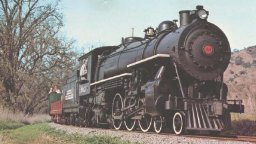 and many others. We loved our summer
excursions to find a train to ride (I even made some recordings)
and were ecstatic at even the thought of finding abandoned trains.
and many others. We loved our summer
excursions to find a train to ride (I even made some recordings)
and were ecstatic at even the thought of finding abandoned trains.
We walked the old Ocean Shore Railroad roadbed many times in search of any kind of artifacts, planned trips to the hills of Santa Cruz to explore the old route of the South Pacific Coast and actually stumbled onto the Swanton Pacific and met Al Smith and the gang in 1979 or 1980 while searching for signs of the old OSRR (I'll have to make a web page telling that story!)
We really liked being near all the railroading activity in Emmett. When we visited from our home on the coast for the summer in 1980 the mills were going at capacity and the cannery was going full stink. Trains were everywhere! (I've got an old super eight of it somewhere.) We went exploring in the ghost town of Pearl (there were actually some buildings left then, and lots of 18" gauge mine track!) We were always trying to find an operating (or operable by mischievous kids...) mine train, and were really intrigued by the 18" gauge size, especially after meeting Al Smith earlier and getting a tour of his engine house FULL of huge 19" gauge steam locos!
We liked it so much that in 1989 the rest of us moved here (Robert was already here) and my parents and I settled here at our place West of Emmett with seven big cottonwood trees and the name 'Cottonwood Hill Ranch' seemed appropriate (I, in my young exuberance, was set on 'Snoopy Dance Ranch', but fortunately was overruled). Of course we had room for a REAL train now and I fiddled with the idea of getting a standard gauge caboose (there's room for about a quarter mile of standard gauge track along the creek from North to South, I could have a 'mobile home on tracks', wouldn't the neighbors love that? -OVERRULED!)
I had done a lot of thinking about gauge and settled on two foot gauge because I liked small narrow gauge trains (we had NO NEED for a BIG train) and thought it was the perfect gauge for two sizes of trains: Park size as in my 1978 Crown Metal Products catalog, or full size narrow gauge like the Maine two footers, which still wasn't overly large, compared to that standard gauge caboose.
Being as my brother Robert was volunteering on the Sumpter Valley Railroad and I then started in 1994, I drew up plans for a three foot gauge railroad. I figured I could use the same size trains, just widen the gauge for possible interchange service with another railroad 125 miles away. I wanted it to be useful, so drew plans for it to go by our stock shoot on the ranch like I'd seen in pictures of Colorado trains, but I LOVED trolleys (Mr. Rogers and Mariott's Great America did that to me!) So the 'Cottonwood Tramway' was mainly a trolley line on our loop of driveways with 50' radius curves. It would have been great, but where and how could I get a three foot gauge trolley with no money down and no payments? Back to dreaming.... I envisioned the 'Cottonwood Extension Railroad' all around the ranch, a mile of track with curves large enough to run a real steam engine!
What's in a name?
That name just wasn't right though. I had strange names for my railroads (actually most were just track plans on paper) like the 'Twigs & Taliped' (T&T with the dubious help of a Thesaurus); the Tritostopem, Endolinen, Southern Tunitas (TEST railroad, a small styrofoam HOn2 1/2, the only model railroad I ever completed, sold before moving to Idaho); the Snails Pace Railroad (SPRR) and others. I found out that Emmett was originally 'Emmettsville' among other names and that Caldwell was once 'Bugtown'! I couldn't resist that, so my railroad cars must be lettered 'Bugtown and Emmettsville'.
Trains of all sizes
Robert was online before the rest of us and was in contact with the 5" scale people who do it Redwood Valley Railway 'Erich Thompson style': 15" gauge models of 3 foot gauge trains. His later chosen railroad name was the 'Idaho Southern and Pacific'. He actually would like to build a train ride in one of Boise's parks! Yes we are all dreamers in this family.
My younger brother Rollie got a chance to work for Idaho Northern and Pacific Railroad, the company that took over operation of the branch lines in the area from Union Pacific. He is still working, though all the mills closed this year and the cannery closed years ago, so the future of the railroad as anything more than a tourist train is kind of shaky.
Anyway...
he knows everybody at the railroad and traded and bartered for an
old speeder trailer (those little flat cars for hauling tools and
such behind the old speeder cars they still use some on
branchlines like the INPR). He got permission to dig up some old
rusted 20 pound rail in Pearl and spent a weekend cutting down
the flat car to 18" gauge! He got inspiration from Al
Jackson (and several others) of Colorado who made 1/2 sized
models of 3 foot gauge on his 18" gauge Woodstock Short Line. Rollie set his track up one
winter (December 1997) and had the 'roller coaster' about where my original
imagined three foot gauge line was to go by the cattle shoot! (You
can see the shoot in the background it the photo below.) 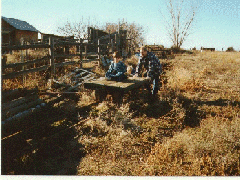 We really liked the size of the
18" gauge equipment and of course I had to rationalize it
all.
We really liked the size of the
18" gauge equipment and of course I had to rationalize it
all.
So I did
a lot of searches for information on the web and in magazines. In
England in the late eighteenth century Sir Arthur Heywood developed the principle of 'minimum
narrow gauge railways' based on the fact that goods and
passengers in small amounts needed to be moved on large estates
and a small railroad was the best way to accomplish this. He
decided on 15" gauge for the smallest size practical for
transport. I liked the standard, but feel it would be nearly
impossible to build a fully enclosed passenger car with a center
isle and at least one seat on each side in 15" gauge. Most
passenger cars of this gauge are 'compartment' cars, where there
is a door for each pair of bench seats and each compartment holds
four adults or six children (Erich Thompsen's RVRy uses the same
principle with open gondola cars).That's Robert with Ty and
Corbin at the RVRy recently in the photo below.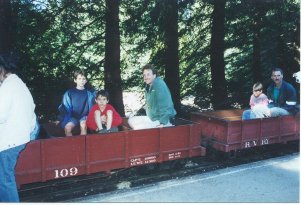 While
these are beautiful, functional models that are the envy of any
good rail fan, if you try to build any kind of 'scale model'
enclosed cars in this size you would not be able to fit an adult
inside without raising the roof about two feet, which begins to
look silly. I was set on a 'Full Size Narrow Gauge Railway'.
While
these are beautiful, functional models that are the envy of any
good rail fan, if you try to build any kind of 'scale model'
enclosed cars in this size you would not be able to fit an adult
inside without raising the roof about two feet, which begins to
look silly. I was set on a 'Full Size Narrow Gauge Railway'.
If you scale Maine two foot equipment to 75 percent and just raise the roof 12 inches, you get very usable cars. Most would be about eight feet tall and four and a half to five feet wide, perfect size for a passenger car (or even a caboose) with an isle in the center and one seat on each side and also a perfect fit on 18" gauge!
I had it,
the conclusive reasoning for 18" gauge! And if you wanted
more stability or conformity to a more standard park train gauge
(like a Crown locomotive)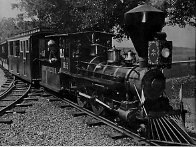 , this equipment would easily
fit on 24" gauge trucks and track.
, this equipment would easily
fit on 24" gauge trucks and track.
Our engine house, under construction, will hopefully have tracks for 15", 18" and 24" trains, so no one is left out!
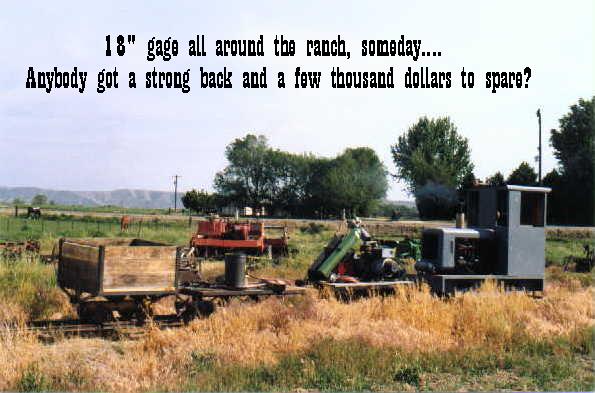
updated 31.08.2001